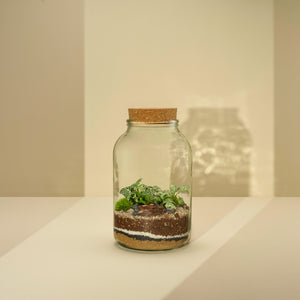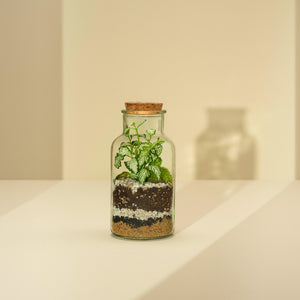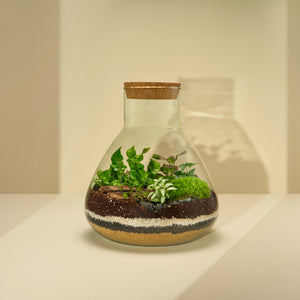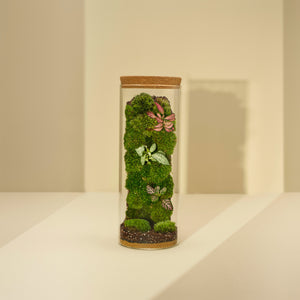Welcome to the world of terrariums – tiny ecosystems that are as low-maintenance as they are magical. Whether you’re a proud new terrarium parent or just need a refresher, this guide has you covered. Let’s dive into the dos, don’ts, and everything in between for keeping your miniature world thriving.

1. Watering: Less is More
First rule of terrariums: avoid watering like it’s a houseplant. Your closed terrarium is smart enough to generate its own condensation and recycle water.
When to Water: Typically, terrariums need a light misting only once a year. Yep, you read that right.
Signs It Needs Water: If the soil looks dry or lighter in color, or the moss feels crispy, it’s time for a spritz. It's also easy to spot if your terrarium still has condensation, it doesn't need watering.
How to Water: Use distilled water to avoid mineral build-up. Mist gently until the substrate darkens but doesn’t flood.
Pro tip: Don’t be fooled by condensation on the glass. Sometimes it can come because the terrarium is either on the cold or in the heat (It will be unfortunate if you leave the terrarium in direct sun) Look at the soil to know what’s up.
2. Lighting: Bright but Indirect
Your terrarium’s vibe is tropical, which means it loves bright, indirect light. Here’s the cheat sheet:
Good Spots: North-facing windows, shaded shelves, or under a terrarium-specific lamp (6000K works wonders).
Avoid: Direct sunlight (instant sauna = dead plants) or dark corners without supplementary light.
Grow Lights: LED or fluorescent lights are ideal for keeping your plants happy without turning up the heat.
3. Temperature: Keep It Chill
Ideal Range: 15-24°C (59-75°F).
What to Avoid: Freezing temps below 17°C or sweltering heat above 30°C.
Pro Tip: Keep it away from heaters, radiators, or sunny windowsills to avoid rapid temperature changes.
4. Maintenance: A Little Goes a Long Way
Even ecosystems need some TLC. Here’s what to watch for:
Pruning: Trim overgrown plants with clean scissors to keep the landscape neat. Use those trimmings to start new terrariums.
Dead Leaves: Remove wilting or dead leaves ASAP to prevent mold. It will be best to use our Terrarium Tweezer Duo especially if you can't reach the dead leaves with your hands.
Glass Cleaning: Use a damp cloth with distilled water to clean smudges or water spots. For algae, mix water with a splash of vinegar or hydrogen peroxide and gently scrub.
Mold: A little mycelium (white fuzz) is fine, but excessive mold? Open the lid for a few hours to dry things out.
We maintain your terrarium for free. Just make sure to send us an email or message us on our website/Instagram. Terrarium Maintenance is needed only when the plants have overgrown and is popping the lid of your cork. When it has mold or if by any chance the plant has died even after just leaving it alone and doing nothing.
5. Bioactive Bonus: Meet Your Tiny Roommates
Many terrariums include microfauna like springtails or tiny isopods. These critters are your clean-up crew, munching on mold and keeping your ecosystem balanced. They’re harmless and essential for long-term health.
We usually add springtails to our bigger terrariums like Terrarium Martin, Terrarium Irena, Terrarium Nenita, Terrarium Rose, Jiordan, Mauricio, Tadeas, Tomas Zuzana, and Sara, once a year. However, if your terrarium is healthy in general then it's not necessary. The smaller terrariums do not need it as much but if you find that your small Anne or Kyla terrariums have mold buildup then we can add more springtails.
6. Common Problems & Solutions
Too Much Condensation: Open the lid for an hour or two to let excess moisture escape.
Wilting Plants: Check soil moisture levels and add a light misting if needed.
Mold or Rot: Remove affected areas and air out the terrarium briefly.
Yellowing Leaves: Likely a sign of overwatering or poor drainage. Let things dry out before adjusting care.
Funky Smells: This could indicate decay. Remove any dead material and ventilate briefly.
7. Decorating & Expanding
Want to add a personal touch?
Tiny Decorations: We offer a wide range of terrarium decorations you can order in our website to make your terrariums more personalized.
New Plants: Quarantine them first to check for pests, then introduce them gently.
DIY Terrariums: Use cuttings from your current plants to create entirely new ecosystems. Easy and cost-effective.
8. Seasonal Adjustments
Keep an eye on your terrarium as seasons change:
Winter: Ensure it’s away from drafts and heat sources.
Summer: Briefly open the lid during extreme humidity or heat to prevent excess moisture.
9. Longevity & Legacy
With proper care, your terrarium could last for years or even decades. Some have been known to thrive for over 50 years! Think of it as a living heirloom for future generations.

Caring for a terrarium is less about constant upkeep and more about observing, tweaking, and letting nature do its thing.




